Articles
- Page Path
- HOME > Korean J Community Nutr > Volume 18(4); 2013 > Article
-
Original Article
- Factors Related to Calceneal Broadband Ultrasound Attenuation, Anthropometric Indexes and Nutrient Intakes among Elementary School Children in Chungnam
- Ye-Jung Kim, Yoon Jeong Choi, Hee-Seon Kim
-
Korean Journal of Community Nutrition 2013;18(4):312-323.
DOI: https://doi.org/10.5720/kjcn.2013.18.4.312
Published online: August 31, 2013
Department of Food Science and Nutrition, Soonchunhyang University, Asan, Korea.
- Corresponding author: Hee-Seon Kim, Department of Food Science and Nutrition, Soonchunhyang University, 646 Eupnae-ri, Shinchang-myun, Asan-si, Choongnam 336-745, Republic of Korea. Tel: (041) 530-1263, Fax: (041) 530-1264, hskim1@sch.ac.kr
Copyright © 2013 The Korean Society of Community Nutrition
This is an Open-Access article distributed under the terms of the Creative Commons Attribution Non-Commercial License (http://creativecommons.org/licenses/by-nc/3.0/) which permits unrestricted non-commercial use, distribution, and reproduction in any medium, provided the original work is properly cited.
- 481 Views
- 0 Download
- 3 Crossref
Abstract
- Variables affecting bone heath of growing children were analyzed among forty nine 10-12 year old elementary students in three rural regions of north west Chungnam area. Information on age of the parents, duration of breast feeding and birth weight were collected from the guardians of the participants and nutrient intake and diet quality were assessed by average of three-day food records of participants with the help of dietitians. Bone health status was measured by calceneal broadband ultrasound attenuation (BUA) using quantitative ultrasound (QUS). Results showed that anthropometic indexes and nutrient intake levels were not different between boys and girls. However, iron intake was significantly lower in girls than in boys. Girls after menarche showed lower intake levels for thiamin, riboflavin, pyridoxine and niacin than girls before menarche. z-scores of BMI were lower than -1 and higher than +1 showed shorter breast feeding period than others but the difference was statistically non-significant. Overall, the subjects did not consume enough s of calcium, vitamin C and folic acid. Zinc intake and BMI were the most significant factors affecting BUA by the results of backward elimination in multiple regression models. Phosphorous and beta-carotene intakes showed significant negative relation with BUA. This study showed that children living in the rural area of Chungnam need extra care to keep their health and nutrient intakes especially for the nutrients known to affect growth. Tailored nutrition education needs to be more focused on the improvement of bone health status of children.
- 1. Anderson JJ. The important role of physical activity in skeletal development: how exercise may counter low calcium intake. Am J Clin Nutr 2000; 71(6): 1384-1386.ArticlePubMed
- 2. Barker ME, McCloskey E, Saha S, Gossiel F, Charlesworth D, Powers HJ, Blumsohn A. Serum retinoids and betacarotene as predictors of hip and other fractures in elderly women. J Bone Miner Res 2005; 20(6): 913-920.PubMed
- 3. Barger-Lux MJ, Heaney RP. Caffeine and the calcium economy revisited. Osteoporos Int 1995; 5(2): 97-102.ArticlePubMedPDF
- 4. Boucher BJ, Melhus H, Michaelsson K. Serum retinol levels and fracture risk. N Engl J Med 2003; 348(19): 1927-1928.Article
- 5. Cadogan J, Eastell R, Jones N, Barker ME. Milk intake and bone mineral acquisition in adolescent girlsrandomised, controlled intervention trial. BMJ 1997; 315(7118): 1255-1260.ArticlePubMedPMC
- 6. Calvo MS, Kumar R, Heath H. Persistently elevated parathyroid hormone secretion and action in young women after four weeks of ingesting high phosphorus, low calcium diets. J Clin Endocrinol Metab 1990; 70(5): 1334-1340.ArticlePubMed
- 7. Glastre C, Braillon P, David L, Cochat P, Meunier PJ, Delmas PD. Measurements of bone mineral content of the lumbar spine by dual energy X-ray aborptiometry in normal children. J Clin Endocrinol Metab 1990; 70: 1330-1333.PubMed
- 8. Chan GM, Hoffman K, McMurry M. Effects of dairy products on bone and body composition in pubertal girls. J Pediatr 1995; 126(4): 551-556.ArticlePubMed
- 9. Choi JS, Ahn EM, Kwon SO, Park YH. Dietary factors affecting bone mineral density in Korean rural postmenopausal women. Korean J Nutr 2012; 45(5): 470-478.Article
- 10. Cummings SR, Black DM, Nevitt MC, Browner W, Cauley J, Esrud K. Bone density at various sites for prediction of hip fractures. The study of osteoporotic fractures research group. Lancet 1993; 341: 72-75.PubMed
- 11. Davies JH, Evans BA, Gregory JW. Bone mass acquisition in healthy children. Arch Dis Child 2005; 90(4): 373-378.ArticlePubMedPMC
- 12. Dawson-Hughes B, Harris SS, Krall EA, Dallal GE. Effect of calcium and vitamine D supplementation on bone density in men and women 65 years of age or older. N Engl J Med 1997; 337(10): 670-676.ArticlePubMed
- 13. Fehily AM, Coles RJ, Evans WD, Elwood PC. Factors affecting bone density in young adults. Am J Clin Nutr 1992; 56(3): 579-586.ArticlePubMed
- 14. Felson DT, Zhang Y, Hannan MT, Anderson JJ. Effects of weight and body mass index on bone mineral density in men and women:the Framingham study. J Bone Miner Res 1993; 8(5): 567-573.ArticlePubMedPDF
- 15. Hansen MA, Overgaard K, Riis BJ, Christiansen C. Role of peak bone mass and bone loss in postmenopausal osteoporosis, 12 year study. BMJ 1991; 303: 961-964.ArticlePubMedPMC
- 16. Hernández ER, Seco C, Corts-Prieto J, Villa LF, Revilla M, Rico H. Gynecological factors and body mass index as determinants of bone mass in normal postmenopausal women. A study with peripheral quantitative computed tomography (pQCT). Eur J Obstet Gynecol Reprod Biol 2000; 92(2): 193-198.ArticlePubMed
- 17. Hill T, Meunier N, Andriollo-Sanchez M, Ciarapica D, Hininger-Favier I, Polito A, O'Connor JM, Coudray C, Cashman KD. The relationship between the zinc nutritive status and biochemical markers of bone turnover in older European adults: the ZENITH study. Eur J Clin Nutr 2005; 59: Suppl 2. S73-S78.ArticlePDF
- 18. Hui SL, Zhou L, Evans R, Slemenda CW, Peacock M, Weaver CM, McClintock C, Johnston CC Jr. Rates of growth and loss of bone mineral in the spine and femoral neck in white females. Osteoporos Int 1999; 9(3): 200-205.ArticlePubMedPDF
- 19. Hyun TH, Barrett-Connor E, Milne D. Zinc intakes and plasma concentrations in men with osteoporosis: the Rancho Bernardo Study. Am J Clin Nutr 2004; 80(3): 715-721.ArticlePubMed
- 20. Katsumata S, Masuyama R, Uehara M, Suzuki K. High-phosphorus diet stimulates receptor activator of nuclear factor-kappaB ligand mRNA expression by increasing parathyroid hormone secretion in rats. Br J Nutr 2005; 94(5): 666-674.ArticlePubMed
- 21. Kirchengast S, Gruber D, Sator M, Huber J. Postmenopausal weight status, body composition and body fat distribution in relation to parameters of menstrual and reproductive history. Maturitas 1999; 33(2): 117-126.Article
- 22. Kohrt WM, Snead DB, Slatopolsky E, Birge SJ Jr. Additive effects of weight-bearing exercise and estrogen on bone mineral density in older women. J Bone Miner Res 1995; 10(9): 1303-1311.ArticlePDF
- 23. Laudermilk MJ, Manore MM, Thomson CA, Houtkooper LB, Farr JN, Going SB. Vitamin C and zinc intakes are related to bone macroarchitectural structure and strength in prepubescent girls. Calcif Tissue Int 2012; 91(6): 430-439.
- 24. Lind T, Lind PM, Jacobson A, Hu L, Sundqvist A, Risteli J, Yebra-Rodriguez A, Larsson S, Rodriguez-Navarro A, Andersson G, Melhus H. High dietary intake of retinol leads to bone marrow hypoxia and diaphyseal endosteal mineralization in rats. Bone 2011; 48(3): 496-506.
- 25. Lonzer MD, Imrie R, Rogers D, Worley D, Licata A, Secic M. Effects of heredity, age, weight, puberty, activity, and calcium intake on bone mineral density in chidren. Clin Pediatr (Phila) 1996; 35(4): 185-189.
- 26. Maser RE, Owusu-Griffin P, Stabley JN, Provost-Craig MA, Lenhard MJ, Farquhar WB. Zinc intake and biochemical markers of bone turnover in type I diabetes. Diabetes Care 2008; 31: 2279-2280.
- 27. Mata-Granados JM, Cuenca-Acevedo R, Luque de Castro MD, Sosa M, Quesada-Gomez JM. Vitamin D deficiency and high seru, levels of vitamin A increase the risk of osteoporosis evaluated by quantitative ultrasound measurements in postmenopausal Spanich women. Clin Biochem 2010; 43: 1064-1068.
- 28. McKay HA, Petit MA, Khan KM, Schutz RW. Lifestyle determinants of bone mineral: a comparison between prepubertal Asian-and Caucasian-Canadian boys and girls. Calcif Tissue Int 2000; 66(5): 320-324.
- 29. Melton LJ III. Epidemiology of hip fracturesimplications of the exponential increase with age. Bone 1996; 18: 121S-125S.
- 30. Metz AL, Walser MM, Olson WG. The interaction of dietary vitamin A and vitamin D related to skeletal development in the turkey poult. J Nutr 1985; 115(7): 929-935.
- 31. Michaëlsson K, Lithell H, Vessby B, Melhus H. Serum retinol levels and the risk of fracture. N Engl J Med 2003; 348(4): 287-294.
- 32. Munger RG, Cerhan JR, Chiu BC. Prospective study of dietary protein intake and risk of hip fracture in postmenopausal women. Am J Clin Nutr 1999; 69(1): 147-152.
- 33. New SA, Solton-Smith C, Grubb DA, Reid DM. Nutritional influences on bone mineral density: a cross-sectional study in premenopausal women. Am J Clin Nutr 1997; 65(6): 1831-1839.
- 34. Nielsen FJ, Lukaski HC, Johnson LK, Roughead ZK. Reported zinc, but not copper, intakes influence whole body bone density, mineral content and T score responses to zinc and copper supplementation in healthy postmenopausal women. Br J Nutr 2011; 106(12): 1872-1879.
- 35. Opotowsky AR, Bilezikian JP. Serum vitamin A concentration and the risk of hip fracture among women 50 to 74 years old in the United States: a prospective analysis of the NHANES I follow-up study. Am J Med 2004; 117(3): 169-174.
- 36. Ott SM. Editorial: attainment of peak bone mass. J Clin Endoclinol Metab 1990; 71(5): 1082A-1082C.
- 37. Park SJ, Moon JW, Kim HJ, Cho MJ. Infantile risk factors for obesity in preschool children. Korean J Pediatr 2008; 51: 804-811.
- 38. Pinheiro MM, Schuch NJ, Genaro PS, Ciconelli RM, Ferraz MB, Martini LA. Nutrient intakes related to osteoporotic fractures in men and women-the Brazilian osteoporosis study (BRAZOS). Nutr J 2009; 8: 6.
- 39. Promislow JH, Goodman-Gruen D, Slymen DJ, Barrett-Connor E. Retinol intake and bone mineral density in the elderly: the Rancho Bernardo study. J Bone Miner Res 2002; 17(8): 1349-1358.
- 40. Ribaya-Mercado JD, Blumberg JB. Vitamin A is it a risk factor for osteoporosis and bone fracture? Nutr Rev 2007; 65(10): 425-438.
- 41. Rizzoli R, Bianchi ML, Garabedian M, McKay HA, Moreno LA. Maximizing bone mineral mass gain during growth for the prevention of fractures in the adolescents and the elderly. Bone 2010; 46(2): 294-305.
- 42. Slemenda C. Prevention of hip fracturesrisk factor modification. Am J Med 1997; 103(2A): 65S-71S.
- 43. Tanaka K, Tanaka S, Sakai A, Ninomiya T, Arai Y, Nakamura T. Dificiency of vitamin A delays bone healing process in association with reduced BMP2 expression after drill-hole injury in mice. Bone 2010; 47: 1006-1012.
- 44. The Korean Pediatric Society. Growth standard of children and youth at 2007 in Korea. 2007. p. 24-25.
- 45. Tkatch L, Rapin Ch, Rizzoli R, Slosman D, Nydegger V, Vasey H, Bonjour JP. Benefits of oral protein supplementation in eldery patients with fracture of the proxinal femur. J Am Coll Nutr 1992; 11(5): 519-525.
- 46. Yeon JY, Sung CJ. A study on dietary mineral intake, urinary mineral excretions and bone mineral density in Korean postmenopausal women. Korean J Community Nutr 2011; 16(5): 569-579.
REFERENCES
Figure & Data
REFERENCES
Citations

- Children's Food Intake and Nutrition Levels, and Obesity by Maternal Employment: Based on the Korea National Health and Nutrition Examination Survey 2013–2015
Geunyeong Kang, Yoonna Lee, Mihyang UM, Seunghee Kye
Korean Journal of Community Nutrition.2019; 24(4): 331. CrossRef - Effects of Nutrition Education Using Dietary Guidebook in Higher Grade Elementary Students of Jeonbuk Area
Mi-Ran Park, Sook-Bae Kim
Korean Journal of Community Nutrition.2018; 23(1): 13. CrossRef - Effects of Dietary Education on Elementary Children in After-school Program in Seoul
Kyung-Hee Kim
Journal of the Korean Society of Food Culture.2014; 29(2): 222. CrossRef
General characteristics of the subjects by gender
1) Mean ± SD
2) Broadband ultrasound attenuation (BUA)
NS: Not significant
Comparison of the variables by the BMI of the study subjects
1) Mean ± SD
2) Broadband ultrasound attenuation (BUA)
abc: Values with different superscript letters within a row are significantly different based on one-way ANOVA followed by Tukey's post hoc test
Dietary intakes of the subjects by sex
1) Mean ± SD
NS: Not significant
Dietary intakes of the subjects by the BMI group
1) Mean ± SD
ab: Values with different superscript letters within a row are significantly different based on one-way ANOVA followed by Tukey's post hoc test
Evaluation of diet quality by sex
1) Nutrient Adequacy Ratio (NAR)
2) Mean ± SD
3) Mean Adequacy Ratio (MAR)
4) Index of Nutrition Quality (INQ)
NS: Not significant
Evaluation of diet quality by the BMI group
1) Nutrient adequacy ratio (NAR)
2) Mean ± SD
3) Mean adequacy ratio (MAR)
4) Index of Nutrition Quality (INQ)
ab: Values with different superscript letters within a row are significantly different based on one-way ANOVA followed by Tukey's post hoc test
Anthropometric and dietary quality of the girls by menstrual status
1) Mean ± SD
2) Nutrient adequacy ratio (NAR)
3) Mean adequacy ratio (MAR)
NS: Not significant
Summary of multiple regression model fit by backward elimination1) for z-score of BUA as a dependant variable
1) Significant level for stay (SLS) was 0.10
1) Mean ± SD 2) Broadband ultrasound attenuation (BUA) NS: Not significant
1) Mean ± SD 2) Broadband ultrasound attenuation (BUA) abc: Values with different superscript letters within a row are significantly different based on one-way ANOVA followed by Tukey's post hoc test
1) Mean ± SD NS: Not significant
1) Mean ± SD ab: Values with different superscript letters within a row are significantly different based on one-way ANOVA followed by Tukey's post hoc test
1) Nutrient Adequacy Ratio (NAR) 2) Mean ± SD 3) Mean Adequacy Ratio (MAR) 4) Index of Nutrition Quality (INQ) NS: Not significant
1) Nutrient adequacy ratio (NAR) 2) Mean ± SD 3) Mean adequacy ratio (MAR) 4) Index of Nutrition Quality (INQ) ab: Values with different superscript letters within a row are significantly different based on one-way ANOVA followed by Tukey's post hoc test
1) Mean ± SD 2) Nutrient adequacy ratio (NAR) 3) Mean adequacy ratio (MAR) NS: Not significant
1) Significant level for stay (SLS) was 0.10

 KSCN
KSCN
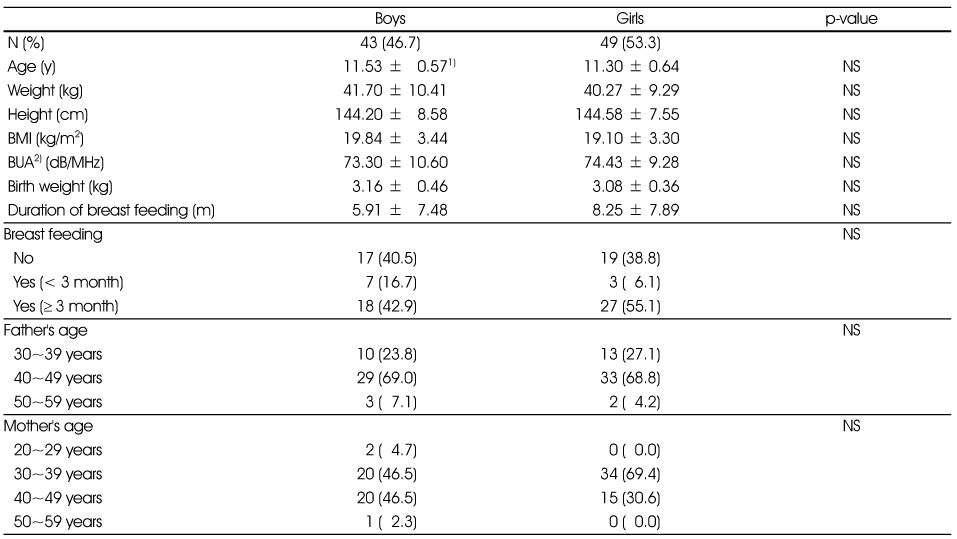
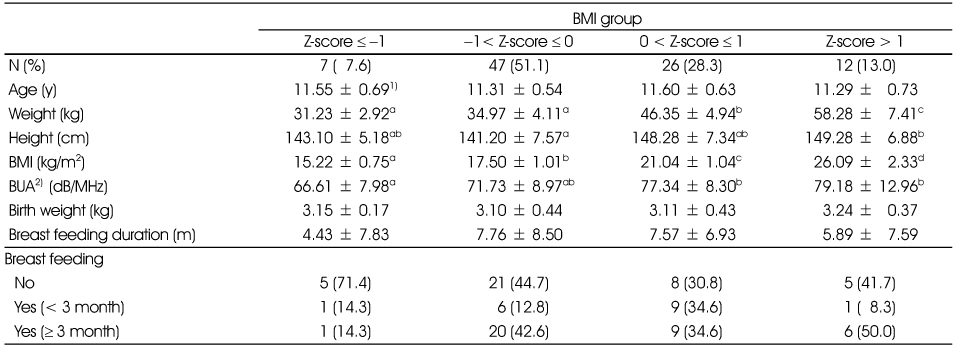
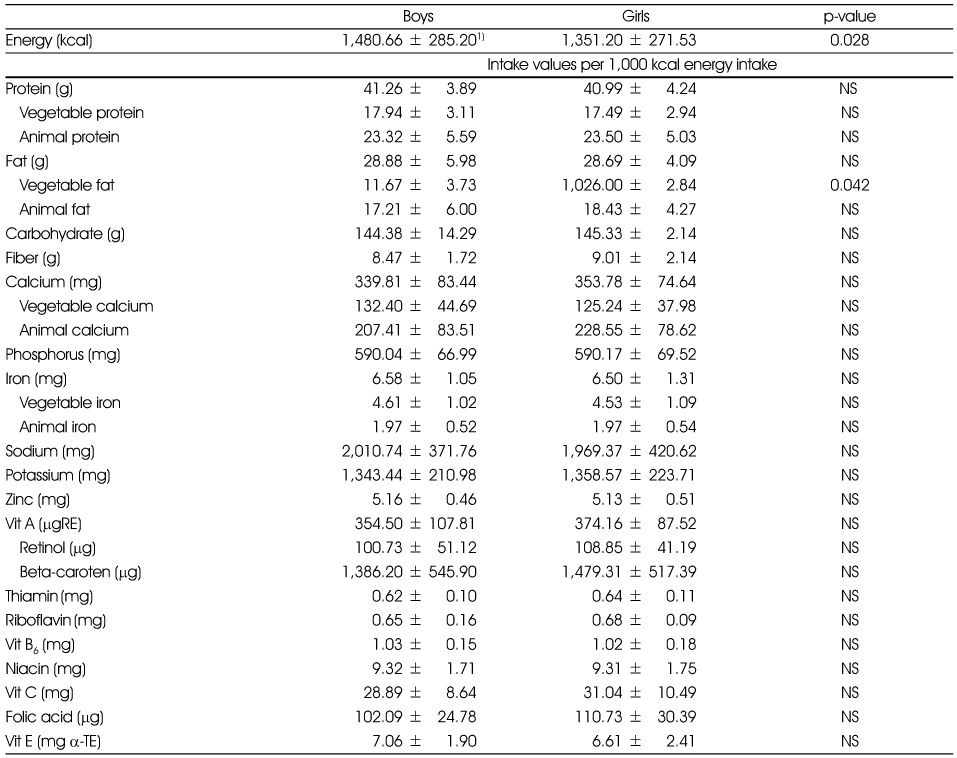
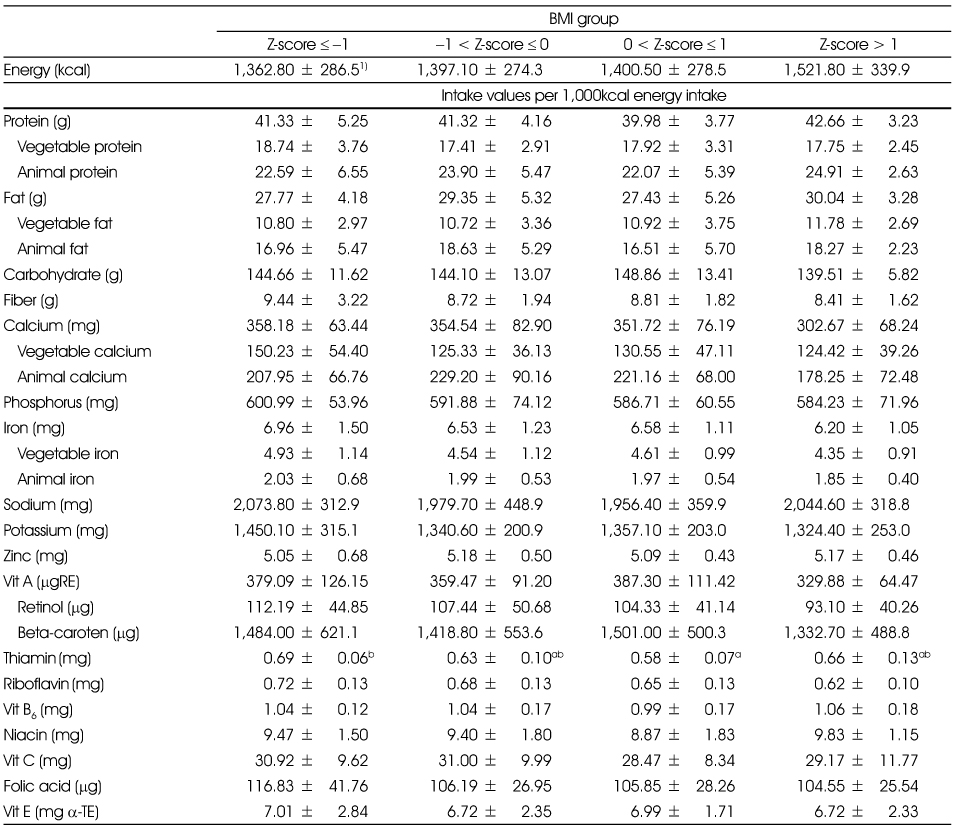

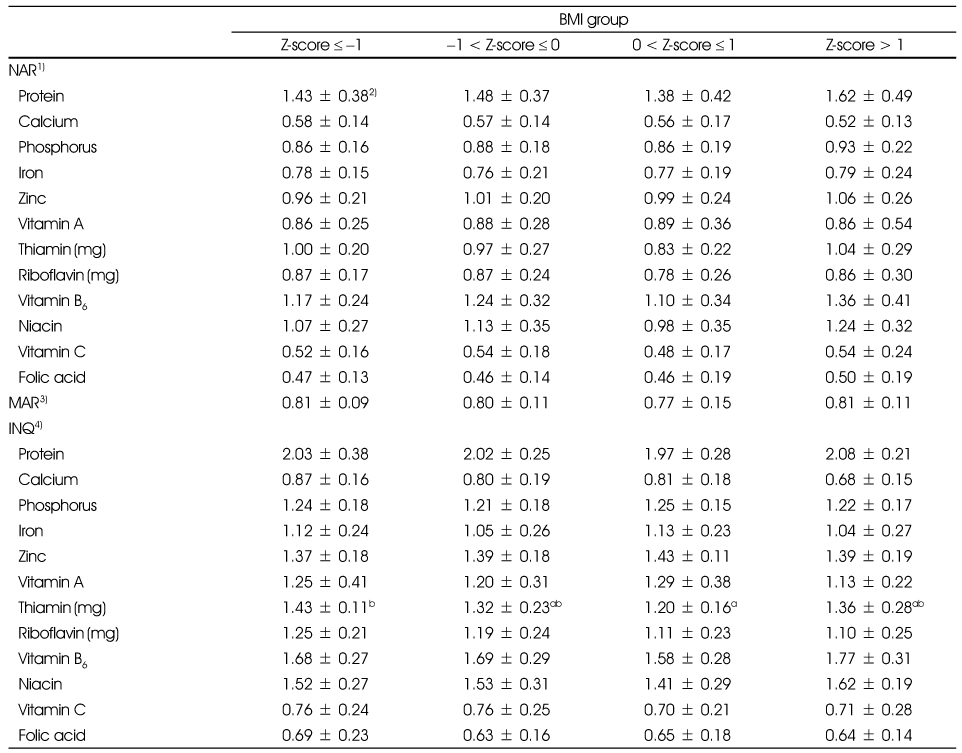
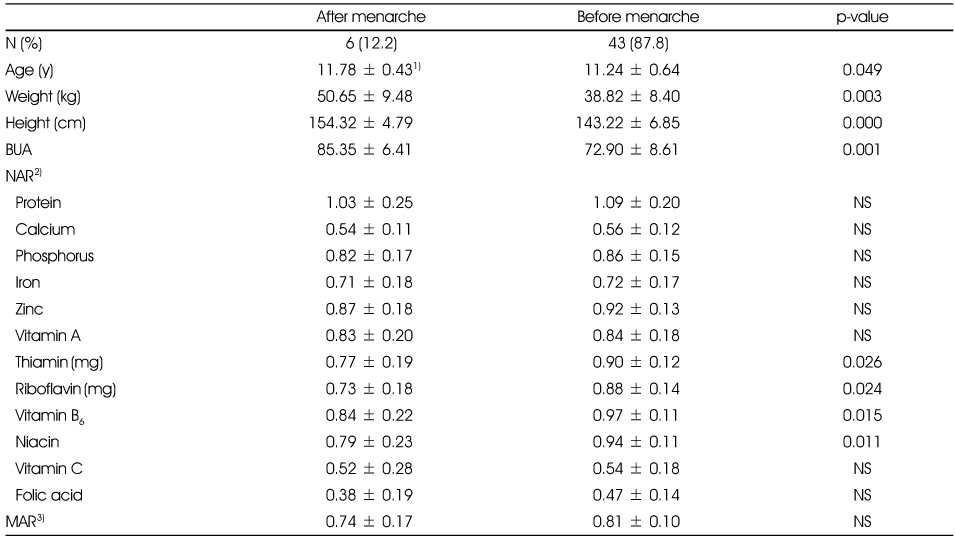
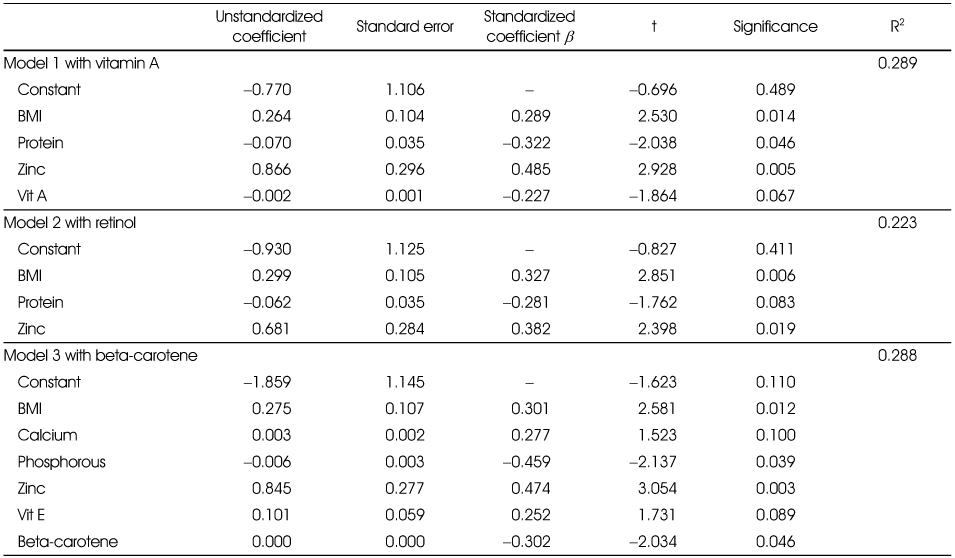
 PubReader
PubReader Cite
Cite


